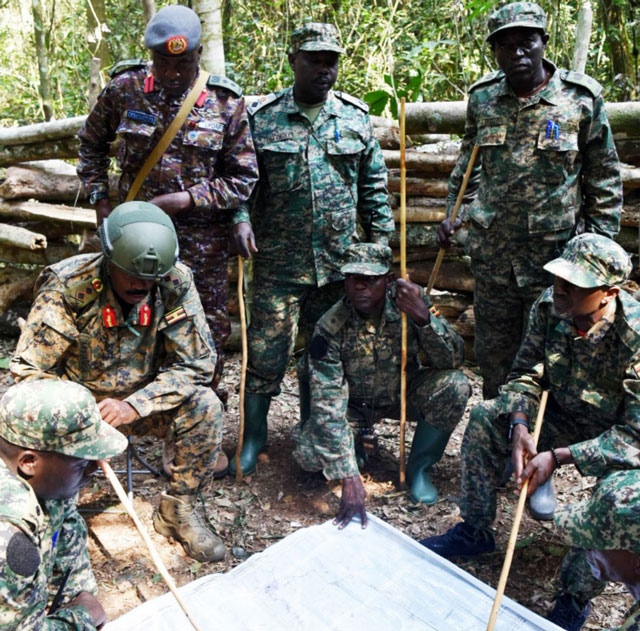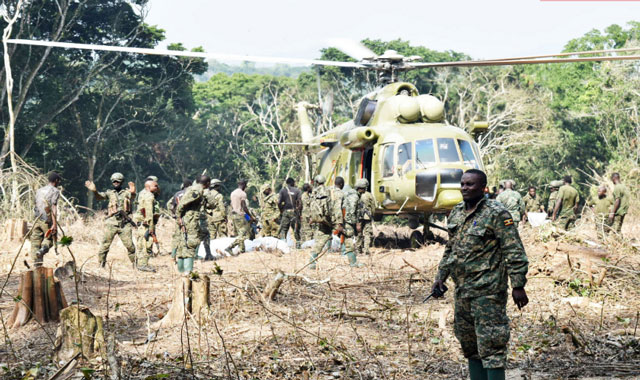
Why it’s about hearts and minds; not bullets
COVER STORY | ANDREW M MWENDA | Kambi ya Yua is an eight-acre hill site in the middle of a jungle that runs for over 100km from Uganda deep into inside of the DR Congo. It has no neighbouring human settlement, no access road, no open space. It is one of the places still eluding civilization and it is inconceivable that human beings would live and survive there. Flying by helicopter from Fort Portal to Kambi ya Yua takes only 30 minutes; from Semuliki Bridge (a UPDF forward operating base inside DRC) to the place takes only about ten minutes.
Looking down from the air, one is spellbound by the breath-taking density of this rain forest. All one can see below is a canopy created by the tops of trees. There are some broken spaces with swamps and shrubs, but they are very few and small in size, not more than two acres. Only the Semuliki river, snaking through the valleys of this dense forest, is visible from above. And yet this is the place inside DRC where ADF established its main base for military training, assembly of bombs, and indoctrination of the young.
At Kambi ya Yua, the cooperation between UPDF and the Congolese army FARDC is very good. Although they occupy different parts of this ridge, they share food and meet daily to discuss joint operations.
Immediately we arrive at the camp, we meet a UPDF platoon that is returning from patrol of the neighboring areas. We are informed this is done on a daily basis to ensure that ADF does not regroup and return to attack the camp.
Indeed, as the 2IC (Second in Command) of the operation, Col. James Kasumba tells us, the night after UPDF’s arrival, ADF attacked the camp and was immediately and easily repulsed, although UPDF lost a soldier. Apparently, this soldier panicked and fired a mortar. Doing so in a jungle, the mortar hit a tree and bounced back, hitting and killing the soldier.

UPDF’s strategy
The physical distance by plane from Semuliki Bridge to Kambi ya Yua is only 10.3km. But, according to the UPDF Brigade Intelligence Officer at Kambi ya Yua, Capt Andrew Tiyebalirwa, it took the Ugandan army ten days to walk through this jungle from Semuliki Bridge to Kambi ya Yua. They launched the ground offensive on December 14 and reached the camp on Christmas eve. Why?
First because available footpaths were created by the ADF which used them to supply its combatants and their families at the camp. UPDF suspected these would be riddled with landmines; an advancing enemy would also be easily subject to ambushes. So UPDF had to cut its own path through the jungle, a slow and laborious process.
Secondly, walking through the jungle, as opposed to flying over it, involves climbing up and down ridges, hills and valleys, making the distance longer. If you add onto this the business of cutting a path out of the forest, then one understands why it took UPDF ten days to cover such a short distance. It also explains why ADF chose this place as its main camp – it is very difficult to access. No wonder, the Congolese army (FARDC) and the UN peace enforcement force (MONSCO) have never been there. Finally, it also explains why UPDF could not find bodies of the dead. The ADF had enough time to take most of the important evidence away from the camp.
It is this context that explains the strategy of heavy aerial (using Sukhoi bombers) and artillery bombardment that marked the commencement of the assault on this specific ADF camp. It also explains the weakness (or lack) of a UPDF communications strategy. Knowing ADF to be a light infantry force, one had to wonder why UPDF chose to use such heavy aerial and artillery bombardment from so a long a distance. It was like using a hammer to kill a fly. But flying to the camp and observing the facts on the ground helped me make sense of the strategy. One needed to heavily degrade, disorganize, and disorient the enemy and do so from a very long distance before launching a ground offensive.
One could not use light artillery with a short range to strike at a camp so many kilometers away. And neither could one walk through the jungle carrying heavy artillery on their heads. Finally, walking through the jungle without having significantly softened the enemy would be suicidal. The ADF would have been able to launch ambushes against the UPDF. Besides, this is ADF’s home base – so they know all the nooks and crannies of the jungle, giving them an advantage over an advancing enemy. Indeed, as Col. Kasumba, told me, the ADF attacked the UPDF a couple of times during the long and slow match by its ground forces to capture and occupy the camp.
When UPDF, backed by FARDC reached and occupied the camp, they found it deserted and most of the evidence of its plans and operations destroyed or carried away. However, the UPDF captured documents that gave a picture of the role this camp played in ADF’s operations.
According to these documents, the camp was occupied by 604 families each of which received a daily ration, all detailed in a book. It was not much and one wonders why so many families would stay far away from civilization to live such a miserable existence. As I will argue in the conclusion, this shows the strength of the ideological convictions that drive this terrorist organisation.
Gen. Muhoozi’s role
One of the least appreciated developments in Uganda is the transformation of UPDF. I made my career as a journalist in large part by exposing the corruption and rot inside this army – the presence of ghost soldiers on its register, the procurement of substandard military equipment, undersize uniforms, expired food rations etc. It had become a springboard for private profiteers.
The post UPDF, the DRC and the ADF war appeared first on The Independent Uganda:.
from The Independent Uganda: https://ift.tt/3f9Teor
0 Comments